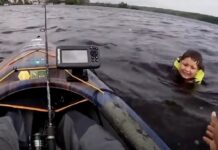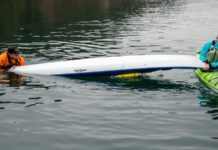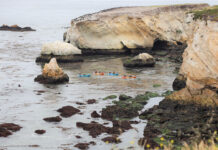Nothing works up a redfish’s appetite quite like a full moon, so when Jack Motley and his kayak-fishing buddy Greg Ammon heard about the November 2016 super moon—the brightest in nearly 60 years—they planned a night-fishing mission.
They put in near the foot of Three Mile Bridge at the mouth of Pensacola Bay on the Florida panhandle, planning to take advantage of the unusually bright moon and the ripping tidal currents it created. And it worked like magic.
“That bite was just on fire,” Motley recalls. “Redfish after redfish. Thirty-five inches. Thirty-seven inches. Forty inches.”
Underneath the Three Mile is one of the best spots for big redfish on the Gulf Coast, and when the bridge lights switch on, so does the bite. The tide works like a conveyor belt at a buffet, sweeping bait into the spotlights all night long. Fat redfish lurk in the shadows, waiting to pounce on anything that shows itself in the light. On a normal night, a kayak angler can catch and release five or even ten large redfish. That night, under the brightest moon since 1948, it was a feeding frenzy.

Motley and Ammon had struck pay dirt under the bridge, about a mile and a half from either shore. It’s a spooky place at night, with massive concrete pylons rising from inky black water. The night was calm and cool, about 50 degrees. The water temperature was in the low 60s.
Around midnight, Ammon reached out to steady himself on one of the concrete bridge supports, and tipped into the water. He was wearing an auto-inflate lifejacket, but it didn’t deploy. Without the benefit of flotation, he had to work hard to keep his head above water in thick winter clothing. His kayak drifted out of reach.
Suddenly the supermoon bonanza had become a life-threatening situation.
“As a battle buddy, I had to make sure he got all the way back to the boat ramp safely.” – Kayak angler Jack Motley
Motley was about 100 yards away when he heard Ammon shout. Motley runs a popular YouTube channel, but filming didn’t even cross his mind. The first order of business was getting Ammon reunited with his kayak, then back on board.
“This was the full trifecta. We had cold water, we had current and we had dark. Oh man, it was dark. It was dark and scary,” Motley says in a video recounting the incident and the lessons it reinforced.

The first of those lessons was to remain calm, says Motley, who grew up lifeguarding and received water survival training as a U.S. Army officer. There’s a saying in the military: Slow is smooth, and smooth is fast. The mantra is especially popular in the combat arms, where operating efficiently despite tremendous stress can be the difference between life and death.
Dark, cold water with a swift-moving current is a stressful place to be, especially when your kayak is out of reach and your lifejacket has malfunctioned. Panic is the enemy in such situations, but it’s also a natural response. “Once you hit that dark, murky water, it just comes over you,” Motley says. “But you can’t let your emotions overcome you, because panicking is 90 percent of drowning.”
Ammon kept his cool, and Motley made sure to keep him that way. The footage begins midway through the crisis, after Ammon was reunited with his boat but still chin deep in cold water more than a mile from shore. In the video, Motley’s voice projects calm.
“What’s your plan here?” he asks conversationally, helping Ammon to focus on the next stage of recovery—and reminding him that they’d talked through these scenarios before.
“Can you get alongside?” Ammon answers, cueing the first step of an assisted rescue. With their kayaks side-by-side, Motley would be able to use his bodyweight to steady Ammon’s kayak as he pulled himself aboard.
Remounting a sit-on-top fishing kayak is not an easy trick, particularly in heavy clothing after several minutes immersed in cold water. Anyone who fishes from a kayak should practice this maneuver, both solo and assisted. The key is to get your belly onto the boat first, pulling with the arms in combination with a powerful scissor kick.
We don’t see it in the video, but Ammon needed several attempts to climb back on to his kayak. Motley knew the clock was running. “You only get so many chances to get back in the kayak,” he says. “You start getting tired, and this time he was getting lethargic. Hypothermia was starting to set in.” Ammon and Motley stuck to the plan. In the video, we hear Motley reminding his partner to use his legs.
“Almost there,” he says. “Kick! Kick! Kick!”
Ammon finally scrambles aboard, and you can hear the relief in his voice. “God, that was expensive,” he says, and it was—Ammon’s rods and GoPro camera were on the bottom of the bay, and his tackle box had floated away. Motley would help his friend count his losses later, but in the moment he changed the subject right back to the task at hand: getting to shore.

One of the most critical times in any rescue is when you first think you’re safe. That’s when the adrenaline wears off, and you can lose your concentration. They’d done the hard part. Ammon was back in his boat. But he was still a mile and a half from shore in the dead of night, mildly hypothermic, in a partially waterlogged kayak that was far tippier than normal.
“I knew that he had been in a really stressful situation, and that’s where it gets dangerous. Those emotions can become almost like a volcano inside you, and even when you’re on your way to safety you can have a meltdown,” Motley says. “As a battle buddy, I had to make sure he got all the way back to the boat ramp safely.”
Ammon didn’t require any additional help on the way in, but Motley was at his side in case he did. That’s a critical safety lesson that is too often overlooked: Whenever you’re on the water, it’s your responsibility to keep an eye out for your friends and other boaters—just as they look after you.
Another lesson is to regularly check and maintain your safety equipment. Ammon’s situation was much more dangerous than it had to be because his self-inflating lifejacket failed to deploy. That left him treading water in heavy clothing until he could grab the handle on the side of his Hobie. (He could have inflated his lifejacket manually using the mouth tube, but with the kayak providing flotation and Motley standing by, he chose to re-enter the kayak first.) The lesson here is if you choose an inflatable lifejacket, check it regularly and replace the cartridge and bobbin at recommended intervals.
A crew gearing up for a night-fishing mission in Port St. Joe, Florida. Essential equipment includes lifejackets, headlamps, and fellow anglers who have your back. | Feature photo: Jeffrey Fortuna









Dress for the water temperature
I am surprised you guys were not wearing wetsuits or drysuits with the water as cold as it was. Here in Wisconsin so many of the kayak fishermen wear their neoprene wadders, which just makes me cringe. The boots on the wadders are so heavy, I don’t know how you could swim in them, much less get back in your kayak. I have a two piece drysuit. I always wear the pants once the water temp is below 70 degrees. I also practice reentrying my kayak several times during the season. Also practice with the drysuit. I wish more fishermen would purchase and use wetsuits or drysuits to stay safe on the water. I also always wear my life jacket.
put a dedicated cleat with a pvc pipe with rope through to use as a step for this reason.